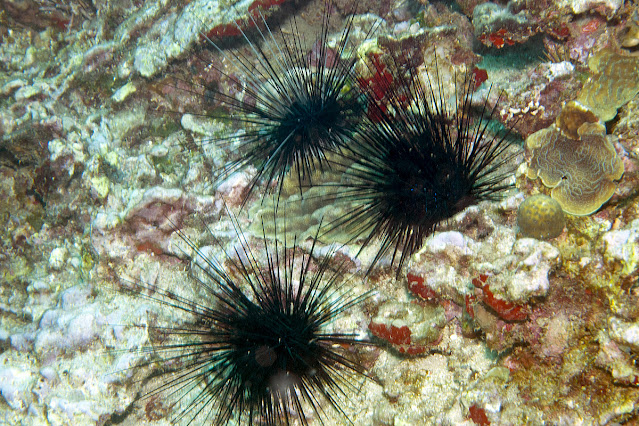Keep an eye out for Sea Urchins
As marine scientists work to figure out what’s affecting precious sea urchin colonies, they ask all divers, snorkelers, swimmers to report all sightings of sea urchins - healthy, ailing or dying - to the network that is tracking disease spread. Dr Anjani Ganase reports.

Healthy, living Diadema urchin
and healthy group of urchins. Photo by K. Marks, sourced from AGRRA Diadema
Response Network.
On Caribbean coral reefs, the long spined urchins (Diadema antiilarum) are important grazers of algae on coral reefs. Algae compete for space with corals and other benthic creatures on reefs, and these urchins maintain algae free surfaces to allow corals to settle and grow.
In mid-February of 2022, a local dive shop observed dozens of dead Diademas in a harbour in St Thomas. With news of the die off, local researchers began investigating neighbouring sites only to observe more dead and sick sea urchins. All observations show that when the urchins become sick, they detach from the bottom, then lose control of their tube feet; and in the last stages, often after two days, they shed their spines and suffer from tissue loss and death. Mortality is high among the infected and the disease transfers quickly to those living in the vicinity. The disease spreads rapidly.
Within a month, sea urchins of neighbouring islands St Johns, Saba and Eustatius have been observed to sicken and die. Since the Atlantic and Gulf Rapid Response (AGRRA) Network started tracking, reports up to today already indicate die offs as far as north as Jamaica, with the closest outbreak to Trinidad and Tobago reported in St Vincent and the Grenadines. The long spined urchins also appear not to be the only species vulnerable to the disease; other species such as the West Indian Sea Egg and the Pencil urchin have also been observed to suffer the same symptoms before mortality.
The Caribbean is no stranger to disease outbreaks on coral reefs. Since the 1970s and 1980s, diseases have devastated coral reefs throughout the Caribbean. During the 1970s, the white disease plagued and killed up to 97 % of all the Acropora branching species throughout the Caribbean. Then during the 1980s, a disease wiped out the same species of D. antillarum throughout the Caribbean within a few years. In Tobago, observations of dead sea urchin skeletons and dying sea urchins with their spines falling off were recorded by the Institute of Marine Affairs in northeast Tobago in the early 1980s. Today there has been some recovery in populations, but the numbers are nowhere close to what used to be. Scientists were never able to determine the agents of the disease.
Over the past 20 or more years, diseases have been spreading throughout the Caribbean infecting corals and other invertebrates like wildfire. This is on top the onslaught of other conditions inflicted by humans and climate change. Causes of the new diseases are typically associated with poorer water quality and warmer temperature conditions that encourage bacteria blooms. Many coral species in Tobago are already infected by a number of diseases, including yellow band and dark spot diseases, and among the most dangerous yet is stony coral tissue loss disease (SCTLD) which is nearby in Grenada. The SCTLD disease targets the coral species that is common on Tobago’s reefs and results in swift mortality.
The onslaught of diseases to the many players on Caribbean reefs highlights our reefs in crisis. Poor reef health and loss of corals project a vulnerable future for Tobago’s reefs considering the important ecological roles they play as fish nurseries. If coral populations cannot maintain their integrity as habitats for resident marine life, there will be consequences on fish stocks for communities who live by the sea and for tourism. There is an urgent need to build local resilience to back-to-back disturbances, be they hurricanes, coral bleaching and diseases. More action is needed to resuscitate coral reefs and their inhabitants.

Sick,
dying Diadema with high loss of spines. Photos above and below by Dr Kimani
Kitson-Walters (Caribbean Netherlands Science Institute), sourced from AGRRA
Diadema Response Network.
Today, scientists in the region are quickly trying to identify the causative agents of the disease, to determine ways to minimize spread and how to treat infected urchins. Initial studies have revealed that the disease is caused by a bacterium and broad-spectrum antibiotics have worked on ailing urchins. Nonetheless the disease results in over 90 % mortality and is highly infectious. As it is not clear how the disease is spreading, scientists are asking that divers be extra careful to avoid making contact with the urchins, and to decontaminate dive gear after visiting a site with sick or dead urchins in order to prevent any spread to other sites you visit.
Scientists are asking for help from everyone who goes into the ocean. People are asked to report any sightings of healthy, sick, or dead urchins on the Diadema response network on AGRRA website: https://www.agrra.org/sea-urchin-die-off/
References: https://www.agrra.org/sea-urchin-die-off/



